Diversifying beyond marine
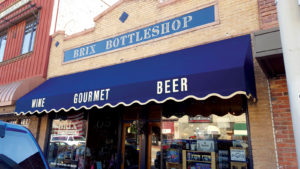
This awning from Lowitz Custom Shoppe was built and installed by the company for a client whose store is located on the main street of town, where many of Lowitz’s awning customers are located. Photo: Lowitz Custom Shoppe.
There’s value in diversifying beyond boats for marine fabricators, like steadier work and income flow, but the move may not be smooth sailing for every business; careful evaluation is critical to avoid sinking.
Business owners are often given conflicting advice. On the one hand, they are cautioned about the dangers of “putting all your eggs in one basket.” On the other hand, they are cautioned to stick with what they know. But this is where marine fabricators can luck out; their skills and equipment translate to a variety of industries beyond boats, potentially helping them stay more productive and profitable year-round. Of course, any expansion into other markets must be carefully explored. Even if similar to marine work—for example, automotive or furniture upholstery—when potential resource demands are taken into account, adding another service to the menu may not make sense. Although every marine fabricator’s business is different, for those casting eyes to other industries, some general rules of thumb apply.
Crawl, walk, run
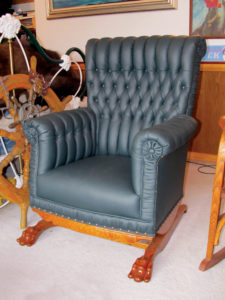
When Lowitz Custom Shoppe was founded more than 61 years ago, it provided just furniture upholstery, later branching into other markets. Although furniture upholstery now comprises a smaller percent of the business, demand is still there. Shown here is an old leather chair the company reupholstered. Photo: Lowitz Custom Shoppe.
Several years ago, Matt Rice, owner of MR Canvas and Upholstery in Fremont, Ohio, needed an enclosure for his boat. Rice, who had been working in the automotive industry since high school—first as a mechanic and later in dealer sales—couldn’t find a shop with the time to do the work, so he decided to tackle it himself. The results were such that other boat owners at the marina asked if he would make enclosures for them. This got him thinking there was a need for another marine shop and so in 2016, he opened for business. He now provides covers, interior and exterior upholstery, bimini tops and more.
Around mid-2017, deciding to capitalize on his background and connections, he branched out to doing automotive interiors for dealers and private vehicle owners, many of whom he reached by advertising this new service on his website. Currently, marine comprises about 80 percent of the business, with auto and some awnings making up the rest. Rice is tentatively exploring the market for awnings, unsure as to whether there’s a need or not. For now, he’s providing only the fabric component.
“I decided to start doing vehicle interiors because I didn’t want to be dependent on one industry,” Rice explains. “If the economy goes south, people stop spending money on their boats, but they still need to spend money on their cars. And who knows, the automotive part of my business may become busier than the marine.”
Rice had to make all the necessary equipment purchases when he started doing marine work (he didn’t have to add to this inventory for the automotive work). At first, he would do the patterning at home in the evenings after his sales job; his sister and mom handled the sewing. Now, he has four employees and works out of two shops—one dedicated to sewing and the other to housing the boats and vehicles currently being worked on.
“Right now is a great time to be in the marine business,” Rice says. “We stay pretty busy year-round because most customers want their boat interiors done during the off-season. So we’re not having to claw and scratch for work.”
Even so, expanding into other areas is in his business plan, although he foresees this will require hiring more employees and moving into a larger building. He intends to focus more on automotive, explaining that his company is becoming fairly adept on the marine side.
“We’re getting quite comfortable with those jobs now, so we’re able to start looking more at the auto,” he says. “I can see us having two divisions. But we need to move slowly. The worst thing you can do is throw too much at people too soon. It’s sort of crawl, walk, run.”
Stay in control
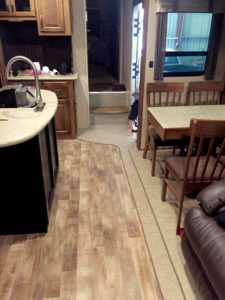
Advanced Canvas & Upholstery Services installed this flooring at the request of Infinity LWV (luxury woven vinyl), resulting in the company being featured in the May 2016 issue of Trailer Life magazine. Photo: Advanced Canvas & Upholstery Services.
Lowitz Custom Shoppe, family owned for 61 years, is located in Kalispell, Mont. The business started out providing furniture upholstery, then added custom design/restoring automotive interiors and restaurant upholstery to its roster, says owner Dave Lowitz.
When he came on board in 1979, the shop was still doing automotive—its primary focus—and furniture upholstery, along with drapery, awnings and a bit of marine work. However, by 1987, the marine side of the business was picking up steam, driven by Lowitz’s preference for working on boats. Now, marine accounts for about 55 to 60 percent of the business (the company offers custom canvas tops, covers, full custom interiors, upholstery and flooring); commercial awnings account for 10 to 15 percent (generally residential work is avoided because these customers are too price-focused; the company provides the entire structure); with furniture making up the rest.
In the early 1980s, the business had 13 employees, but by 2000 this count had dwindled. Now, he, two family members and one (unrelated) employee keep things running. Why the downsizing?
“It was hard to find employees who had the skills,” says Lowitz. “Hiring and training them is expensive and then the employee would stay just a few years and would leave the company, sometimes attempting to start a competing business.”
Lowitz says the company is keeping busy, especially since it is working on boats year-round. If he was going to expand, he’d go deeper into the three markets he’s already serving, but this would require hiring more employees, something he’s hesitant to do. It would also necessitate more space. Although Lowitz Custom Shoppe owns the 6,000-square-foot building it is currently working out of and at one time occupied the entire structure, the company is only using 4,000 square feet of it, leasing out the remainder. It also rents a 1,000-square-foot space where the metal work for the awning structures is done.
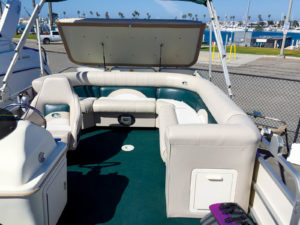
Advanced Canvas & Upholstery Services provides full marine services, such as covers, enclosures, upholstery, canopies and more. Shown here is a Smoker Craft pontoon boat, renovated/redone by the company. Photo: Advanced Canvas & Upholstery Services.
If he were to venture into another market, it would be automotive interiors because of the strong demand. “We get calls all the time for custom interior work from vehicle owners,” says Lowitz. “But again, manpower and space are considerations. For now, our current arrangement allows for greater control over quality, better profits and fewer headaches.”
Take a chance
Four years ago, Stephen Kåmark, president and lead fabricator of Advanced Canvas & Upholstery Services, purchased an existing Oxnard, Calif., business that had been in the area for 20 years. The company provides products to numerous industries, such as marine (covers, enclosures canopies/sunflys, fender hooks, upholstery and more); industrial (covers and protection); military/aerospace; and the auto, aircraft, RV and residential/commercial recreation industries. About 70 percent of the work the company does is marine-related.
When he bought the shop, its primary markets were marine and industrial. The previous owner had also established a relationship with the U.S. Department of Defense (DoD) that Kåmark maintained. During his ownership, he’s added military and aerospace prototyping, aircraft, awnings and shades and EZ2CY® enclosures.
“By providing to these other markets, it gets our name out to a broader spectrum of clientele,” Kåmark explains. “It keeps us very busy with almost an unnoticeable off-season; then again, it is Southern California so people are always using their boats.”
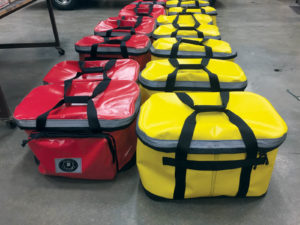
Producing custom bags has allowed Custom Canvas Alaska to stay busy during the winter offseason. These were done for a customer who owns a truck fleet and wanted
each vehicle to carry an emergency cold-weather gear bag. Photo: Custom Canvas Alaska LLC.
As for employees, it’s just Kåmark and his wife—“We’re always looking for good people but we can’t find them,” he says. However, the company has partnered with two production shops that assist with canvas covers and have CAD and cutting capabilities. Kåmark also purchases custom hardware from these companies. For awning projects he provides the fabrics, subcontracting out the framework and installation.
Most of the work for these industries involves using the same standard tools used by marine fabricators—scissors, razor blades, marking pencils, rulers, sewing machines, needles, threads and the like. Others, for example the military, require special materials, such as textiles with flame-retardant properties or those meeting other specifications. But those aren’t the only differences.
“Reaching out to the aviation, DoD and military sectors requires high precision and short deadlines,” he says. “Some of these other markets require stacks of paperwork, explanations and insurance requests. Still, I think diversification within a trade is a good asset. But it’s important to evaluate the demands so we don’t shoot ourselves in the foot and not be able to deliver.”
Kåmark’s advice to marine fabricators mulling over potential opportunities? “Take chances in the areas you think you can handle.”
Pamela Mills-Senn is a freelance writer based in Long Beach, Calif.
 TEXTILES.ORG
TEXTILES.ORG 






